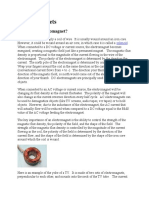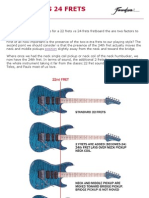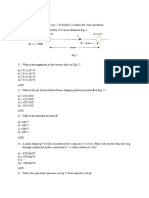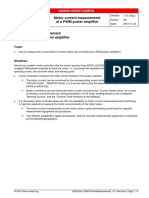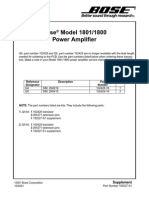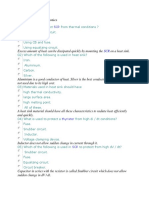Guitar String Hot Wire Cutter
Guitar String Hot Wire Cutter
Uploaded by
Bil AndersenCopyright:
Available Formats
Guitar String Hot Wire Cutter
Guitar String Hot Wire Cutter
Uploaded by
Bil AndersenOriginal Description:
Copyright
Available Formats
Share this document
Did you find this document useful?
Is this content inappropriate?
Copyright:
Available Formats
Guitar String Hot Wire Cutter
Guitar String Hot Wire Cutter
Uploaded by
Bil AndersenCopyright:
Available Formats
Home Sign Up!
Browse Community Submit
All Art Craft Food Games Green Home Kids Life Music Offbeat Outdoors Pets Photo Ride Science Tech
Guitar String Hot Wire Cutter
by BigRedRocket on December 12, 2010 Table of Contents Guitar String Hot Wire Cutter . . . . . . . . . . . . . . . . . . . . . . . . . . . . . . . . . . . . . . . . . . . . . . . . . . . . . . . . . . . . . . . . . . . . . . . . . . . . . . . . . . . . . . . . . . . . . . . . . . . . . Intro: Guitar String Hot Wire Cutter . . . . . . . . . . . . . . . . . . . . . . . . . . . . . . . . . . . . . . . . . . . . . . . . . . . . . . . . . . . . . . . . . . . . . . . . . . . . . . . . . . . . . . . . . . . . . Step 1: The Wire & Electrons . . . . . . . . . . . . . . . . . . . . . . . . . . . . . . . . . . . . . . . . . . . . . . . . . . . . . . . . . . . . . . . . . . . . . . . . . . . . . . . . . . . . . . . . . . . . . . . . . . Step 2: The Circuit . . . . . . . . . . . . . . . . . . . . . . . . . . . . . . . . . . . . . . . . . . . . . . . . . . . . . . . . . . . . . . . . . . . . . . . . . . . . . . . . . . . . . . . . . . . . . . . . . . . . . . . . . Step 3: Adjustments and Variability . . . . . . . . . . . . . . . . . . . . . . . . . . . . . . . . . . . . . . . . . . . . . . . . . . . . . . . . . . . . . . . . . . . . . . . . . . . . . . . . . . . . . . . . . . . . . Step 4: The Wire . . . . . . . . . . . . . . . . . . . . . . . . . . . . . . . . . . . . . . . . . . . . . . . . . . . . . . . . . . . . . . . . . . . . . . . . . . . . . . . . . . . . . . . . . . . . . . . . . . . . . . . . . . . Step 5: The Frame . . . . . . . . . . . . . . . . . . . . . . . . . . . . . . . . . . . . . . . . . . . . . . . . . . . . . . . . . . . . . . . . . . . . . . . . . . . . . . . . . . . . . . . . . . . . . . . . . . . . . . . . . Step 6: Cutting . . . . . . . . . . . . . . . . . . . . . . . . . . . . . . . . . . . . . . . . . . . . . . . . . . . . . . . . . . . . . . . . . . . . . . . . . . . . . . . . . . . . . . . . . . . . . . . . . . . . . . . . . . . . Related Instructables . . . . . . . . . . . . . . . . . . . . . . . . . . . . . . . . . . . . . . . . . . . . . . . . . . . . . . . . . . . . . . . . . . . . . . . . . . . . . . . . . . . . . . . . . . . . . . . . . . . . . . . . Comments . . . . . . . . . . . . . . . . . . . . . . . . . . . . . . . . . . . . . . . . . . . . . . . . . . . . . . . . . . . . . . . . . . . . . . . . . . . . . . . . . . . . . . . . . . . . . . . . . . . . . . . . . . . . . . . . 1 2 2 3 4 4 5 6 7 7
http://www.instructables.com/id/Guitar-String-Hot-Wire-Cutter/
Intro: Guitar String Hot Wire Cutter
This is as simple as it gets. We take an broken E-string (the small one) off an electric guitar and make a hot wire foam cutter out of it. The details are flexible. A hot wire cutter is simple. Take a wire and pump some electrons through it so that it heats up and bingo, it'll cut foam. What we need: A wire (the guitar string) A frame (to hold the wire and put tension on it) Moving electrons (the power supply)
Image Notes 1. A hot guitar string. Watch out foam, we are coming for you.
Image Notes 1. There is a wire here, it is hard to see. 2. Aluminum Bar.
Step 1: The Wire & Electrons
Before you build the frame, you should test your wire. It doesn't need to be taunt to test its heating capability. In this case, I hooked the wire up and attached to it a power supply. Lets talk about the power source: Ideally you might have a variable DC power supply. In my case pumping 11.1 Volts @ 1.7 Amps did the trick. Varying the voltage will change the current. (V=I*R) The power (P=I*V) dictates the temperature of the wire. The more current, the more electrons are moving and smashing into the wire (resistance) and thereby heat it up. If you don't have a power supply you should get one, they are very useful. But really, if you don't have one you can get buy with other power sources. Here are a few ideas: 1. A wall wart. These are cheap and prevalent, but it will be hard to find one that can put out a couple amps. That is the problem with any power supply you try to use. The power supply that I have can put out 5A @ 18V which is pretty good. Usually, wall warts can do 0.5A which probably isn't going to cut it. 2. A hacked computer power supply This is a simple hack. PC power supplies are all over the place. You can make a nice 5V/12V supply for next to nothing. Just search for instructables related to that. Fixed vs. Variable. Because we are using some random wire the voltage needed to drive the right ammount of current through the wire will vary. This is because the resistance of the wires will vary. So, ideally, we want a variable power source. This will also allow us to adjust the voltage and therefore the temperature of the wire if we'd like. If your power source is fixed, that is no problem. We have another option. We can still adjust the current draw of the wire by changing the resistance of the system.
http://www.instructables.com/id/Guitar-String-Hot-Wire-Cutter/
Image Notes 1. We're cooking now!
Image Notes 1. So I don't forget.
Step 2: The Circuit
The circuit is a simple as it gets. Current through a resistor. This is the classic V=I*R. Given that my voltage is 11.1 V and my current is 1.7A I can find the resistance of the wire 11.1/1.7=6.53 Ohms. A quick note. The resistance of the wire will increase as it heats up. For instance, when I first connect my wire at 11.1 V it pulls more than the 1.7A. Then, as the wire quickly heats up the current decreases to a lower value. !!!!MATH!!!! These are the important equations (only simple algebra here). Ohms Law: V=I*R Power Law: P=I*V The reistance of the wire is dependant upon a factor r, (r=R/L ) i.e a shorter wire of the same material has less resistance. Temperature is proportional to power dissipation per length. T~P/L Playing with the math get us a relation between the temperature and Voltage and Length and the properties of the wire. T~P/L=I*V/L=V^2/(R*L)=V^2/(r*L^2) T~V^2/(r*L^2) Thus for a given voltage, decreasing the length of the wire, increases the temperature. This makes sense, as the shorter wire has less resistance and therefore with the set voltage will have a higher current draw, thereby heating it up more. Plus it is shorter, so the shorter wire has more power dissipation/length thus heating it even more. (hence the 1/L^2 factor) Also, changing the wire type 'r' changes the temperature. Use a higher resistance material and that will decrease the temperature because less current is drawn, therefore less power. See, this is simple. These relations then give us a way to adjust the size of the hot wire cutter if need and keep the temperature roughly the same.
Image Notes 1. There is a wire here, it is hard to see. 2. Aluminum Bar.
http://www.instructables.com/id/Guitar-String-Hot-Wire-Cutter/
Step 3: Adjustments and Variability
Adjustments & Variable Control If you don't have a variable power supply, don't worry. Lets look at my case. I was running at 11.1 Volts @ 1.7 Amps. Now lets pretend that I only had a 12V supply that can put out the required amperage. If I used that 12 volts, it might just work fine. The wire will get hotter. But lets say that I want to have the same temperature. Now I need an 11.1 Volt drop across the heating wire with 1.7 Amps. This is going to require a resistor in series with the heating wire to drop that additional 0.9 Volts. Thus, @ 1.7 Amps and 0.9 Volts we get R=V/I = 0.9/1.7 = 0.53 ohms. This is pretty small and it is going to be hard to to find a resistor or potentiometer that can work accurately at such a small value. An easy way around this is to just increase the length of the cutting wire. T~Vo^2/(ro*Lo^2)=V^2/(ro*L^2) Where, ro is the resistance per length of the wire, Lo is the original length, L is the new length and Vo is the original Voltage and V is the new voltage. 11.1^2/(ro*Lo^2)=12.0^2/(ro*L^2) The resistance per length of the two wire are the same. The voltage has changed. Now we can find out what the change in length of the wire needs to be. 12.0^2/11.1^2 = L^2/Lo^2 12.0/11.1 = 1.081 = L/Lo So we just need to make the wire 8% longer and everything will be fine. This is the power of mathematics. We can working around these problems easily. So, by making the wire a little longer we were able to work with the slightly larger power supply.
Step 4: The Wire
Most likely, your wire won't be just the same as mine. The resistance is going to vary. This is why you will have to play around with the voltage and test the heat of the wire on whatever foam you'd like to cut. Besides this fact, really any typical metal wire will do. Steel has a good resitance to it. You can try different gauges of wire, but as you increase the diameter of the wire you will decrease the resistance. T~V^2/(r*L^2) Then, for a given voltage, the wire will heat up more. However, this is considering a constant voltage. And since I=V/R the current is going to increase substantially. You can use the relations shown before to make changes in your design. Also, having a variable power supply lets you get around all this math. You can just hook it up, start at a low voltage, and crank it up until it heats up as much as you would like.
Image Notes 1. Guitar String. 2. Just wrap it around a bunch until it is stuck.
Image Notes 1. A hot guitar string. Watch out foam, we are coming for you.
http://www.instructables.com/id/Guitar-String-Hot-Wire-Cutter/
Step 5: The Frame
The frame puts tension on the wire so that it will cut well. The only restriction is that the frame should not conduct electricity. We want the current to pass through the wire, not the frame. The frame that I have made here is made of conductive metal, however I've made sure that there is no conductive path through it. This frame also has an adjustable tension. This is useful since I can tighten the wire to whatever tension I would like. I also made it very big. I needed this to cut out wing sections. You certainly can make a small (or larger yet) one yourself. All that really matters is that you wire is properly heating up and has proper tension. (and remember, changing the wire length changes the heating) So the frame needs to be able to hold that tension consistently. All of the parts shown here are available at any normal hardware store. My frame consists of a aluminum cross bar and two 1/4" threaded rods. One the the rods is mounted tight. The other one, the one with the electrical tape on it preventing conduction, is mounted a little loose. The bolts keep it in place, but we don't want it too tight, otherwise the tensioning system won't work well. It should just pivot around the main bar. The wire was attached by cutting too grooves with my old craftsman rotary tool into the threaded rods. One end of the guitar wire has a ball with a hole in it. I fed the wire through that hole and looped it through the groove. This gave a sold anchor at that point. The other end of the wire was simple wrapped around the threaded rod and through the groove. After a few wraps it was holding well. The tensioning system is attached to the other end of the threaded rod. It is just a sting (avoiding conduction again) attached to a wire tensioner. Both ends are fixed with bolts. The tensioner is twisted until a good amount of tension is on the guitar string. Don't over do it, or you'll break the wire.
Image Notes 1. There is a wire here, it is hard to see. 2. Aluminum Bar.
Image Notes 1. Electrical tape to avoid conduction.
http://www.instructables.com/id/Guitar-String-Hot-Wire-Cutter/
Image Notes 1. The electrical tape joint in exploded view. Don't let that frame conduct.
Image Notes 1. There is that ball looped through the groove
Image Notes 1. Guitar String. 2. Just wrap it around a bunch until it is stuck.
Image Notes 1. Wire tensioner.
Step 6: Cutting
The power supply is connected to the wire. I attached the alligator clips to the threaded rod. Cutting foam is a straight forward process. You want the wire to be hot enough cut easily, but not too too hot, otherwise it will melt away too much foam. As the wire is cutting, you'll want to cut at a smooth speed. If you sit at one place for a while you will melt the area around it leaving bumps. Also, don't cut too quickly as you will bend the wire altering it's shape and therefore the shape of your cut. So, use a steady slow cut and all will be good. And there we have it a simple hot wire cutter + theory. All is well.
http://www.instructables.com/id/Guitar-String-Hot-Wire-Cutter/
Image Notes 1. A fuzzy view of the wire cutting the foam. It works like a dream and we've been using it to cut out wing sections for RC airplanes.
Related Instructables
To String or Not to String: How to Replace Strings of a Steel-String Acoustic Guitar by sam_farias
How to Make an Air Guitar! by Slayerfan666
Guitar String Bracelet by libraryCat
How To String a Re- Guitar by string an alvincredible Acoustic Guitar, 6 easy steps with video clips by kylebp
How to Play, "Name," by The Goo Goo Dolls Without Breaking a String! by TNovelist
Comments
4 comments
Add Comment
Dec 22, 2010. 4:22 PM REPLY
cyprian916 says:
one suggestion maybe you could use an old saw frame maybe a jewelry saw frame since those hold thing pretty tight.
rimar2000 says:
Very good work. I have two suggest:
Dec 21, 2010. 3:10 AM REPLY
1) when the wire is heated, it expands a lot. The device would improve by adding a spring at one end, and a small pulley for the wire to slide on it. Although threaded rods have some flexibility, spring is the best solution. In your design, it could be also in the rear tensor. 2) As Phil B says, a rheostat enhances the utility of the device. I was successful in making one with the simple appeal to attach a piece of electric cooker/heater resistance over a piece of floor pottery, using silicone sealant. I made the slider with a snap clothespin, one of whose halves have a contact in bronze. IMPORTANT: silica should be dried thoroughly before circulating current. It should be left to dry for at least twelve hours.
rich2871 says:
Dec 20, 2010. 10:53 PM REPLY Thats a great thing, I have wanted to make a foam cutter before for various projects. I am into R/C planes too and this will come in handy, one thing you can do to help get straight cuts is to make a pivot point where you can mount it to the table and let gravity pull the heated wire at just the right speed and this will also give you a straighter cut by taking the human factor out of it. Just like a bandsaw going through a piece of metal stock. Nice work!
Phil B says:
Dec 20, 2010. 6:03 AM REPLY
I appreciate your current calculations using Ohm's Law. The guitar string for a cutter wire is a great idea. I improvised a hot wire cutter in step 2 of this Instructable. Although I attempted to use Ohm's Law, in the end I resorted to trial and error using some stainless steel wire and a homemade 12 volt battery charger presented in another Instructable. As you can see from the first Instructable I linked, I added length to the cutter wire and wrapped it around a piece of wood to make a crude wire wound resistor so I could get the right heat to the portion of the wire I was using as a cutter. Thank you for your Instructable.
http://www.instructables.com/id/Guitar-String-Hot-Wire-Cutter/
You might also like
- DIY TaserDocument11 pagesDIY TaserLord_Darth_VaderNo ratings yet
- Build A Microwave Transformer Homemade WelderDocument26 pagesBuild A Microwave Transformer Homemade WelderClark McCulloughNo ratings yet
- How To Build A Vacuum Tube Tesla Coil VTTCDocument18 pagesHow To Build A Vacuum Tube Tesla Coil VTTClthai7278No ratings yet
- 12KW Induction HeaterDocument8 pages12KW Induction HeaterEric Driscoll100% (2)
- How To Build A Vacuum Tube Tesla Coil VTTCDocument18 pagesHow To Build A Vacuum Tube Tesla Coil VTTCЗорица ЋирићNo ratings yet
- Simple TaserDocument5 pagesSimple TaserLord_Darth_VaderNo ratings yet
- Tle Project-Night SwitchDocument2 pagesTle Project-Night SwitchDan Felix100% (1)
- Led Monitor: Service ManualDocument16 pagesLed Monitor: Service ManualabdelkaderNo ratings yet
- Solar Powered Water Purification SystemDocument86 pagesSolar Powered Water Purification Systemdawit100% (2)
- KemppiDocument43 pagesKemppiIon Suditu100% (1)
- How To Build A Slayer ExciterDocument6 pagesHow To Build A Slayer ExciterKevin BinnyNo ratings yet
- How To Weld - TIG WeldingDocument14 pagesHow To Weld - TIG Weldingjumpupdnbdj100% (2)
- How To Weld TIGDocument14 pagesHow To Weld TIGMarcel PantanoNo ratings yet
- Using Ac With Leds (Part 3) - The Big LightDocument12 pagesUsing Ac With Leds (Part 3) - The Big LightAmarlo EuNo ratings yet
- Electronics Made Easy: All Art Craft Food Games Green Home Kids Life Music Offbeat Outdoors Pets Photo Ride Science TechDocument11 pagesElectronics Made Easy: All Art Craft Food Games Green Home Kids Life Music Offbeat Outdoors Pets Photo Ride Science TechFelix JuniorNo ratings yet
- How To Install An Electric FenceDocument9 pagesHow To Install An Electric FenceAbu FadilahNo ratings yet
- Joule Thief Battery ChargerDocument7 pagesJoule Thief Battery ChargerAfshin NazemiNo ratings yet
- Ignition Coil High Voltage DisplayDocument13 pagesIgnition Coil High Voltage DisplayHutanu GabrielNo ratings yet
- Simple Styrofoam Hot Wire CutterDocument14 pagesSimple Styrofoam Hot Wire Cuttermarius_danila8736100% (2)
- AA Battery Powered Tesla Coil PDFDocument13 pagesAA Battery Powered Tesla Coil PDFNaren ArchaNo ratings yet
- Mini Tesla Coil 100kv RevisedDocument9 pagesMini Tesla Coil 100kv RevisedmadmhackzNo ratings yet
- Small Welder For Joining Nichrome and Nickel WiresDocument7 pagesSmall Welder For Joining Nichrome and Nickel WiresJulio_Cesar1981No ratings yet
- How To Build A Vacuum Tube Tesla Coil VTTCDocument18 pagesHow To Build A Vacuum Tube Tesla Coil VTTCjumpupdnbdjNo ratings yet
- Power LED S - Simplest Light With Constant CurrentDocument14 pagesPower LED S - Simplest Light With Constant Currentdraj1968No ratings yet
- AA Battery Powered Tesla CoilDocument13 pagesAA Battery Powered Tesla CoiljumpupdnbdjNo ratings yet
- AA Battery Powered Tesla Coil 1Document12 pagesAA Battery Powered Tesla Coil 1Sumit MishraNo ratings yet
- How To Make A Negative Ion Air IonizerDocument24 pagesHow To Make A Negative Ion Air IonizergabigowrielNo ratings yet
- AnemometerDocument5 pagesAnemometerLord_Darth_VaderNo ratings yet
- Build A Very Simple AM TransmitterDocument7 pagesBuild A Very Simple AM TransmitterJames MarovichNo ratings yet
- Hot Wire Foam CutterDocument14 pagesHot Wire Foam CutterjumpupdnbdjNo ratings yet
- Smart Drive Wind Turbine TutorialDocument13 pagesSmart Drive Wind Turbine TutorialMarius DanilaNo ratings yet
- 9V IR DetectorDocument11 pages9V IR DetectorRicardo MontoyaNo ratings yet
- The Valve Caster 20 Tube Boost and OverdriveDocument8 pagesThe Valve Caster 20 Tube Boost and OverdriveBambang KaryantoNo ratings yet
- Bar A LedsDocument23 pagesBar A LedsaNo ratings yet
- Using Ac With Leds (Part 2) - and Make This Handy Counter LightDocument14 pagesUsing Ac With Leds (Part 2) - and Make This Handy Counter LightAmarlo EuNo ratings yet
- Building A Solid State Tesla CoilDocument24 pagesBuilding A Solid State Tesla CoilWar machinesNo ratings yet
- Homemade Spot Welder: Home Sign Up! Explore Community SubmitDocument11 pagesHomemade Spot Welder: Home Sign Up! Explore Community SubmitCarlos CostaNo ratings yet
- Convert An ATX Power Supply Into A Regular DC PowerDocument11 pagesConvert An ATX Power Supply Into A Regular DC Powerhelderrui100% (1)
- Ac Resistance Evaluation of Foil, Round and Litz Conductors in Magnetic ComponentsDocument74 pagesAc Resistance Evaluation of Foil, Round and Litz Conductors in Magnetic ComponentsRodrigo CunhaNo ratings yet
- 2n3055 Flyback Transformer Driver For BeginnersDocument7 pages2n3055 Flyback Transformer Driver For Beginnersjmdvm100% (1)
- Short Circuit Protection For Almost Any Power SuppDocument8 pagesShort Circuit Protection For Almost Any Power SuppYatheesh KaggereNo ratings yet
- Block DiagramDocument42 pagesBlock DiagramAbhishek KatiyarNo ratings yet
- Fireworks IgniterDocument10 pagesFireworks Igniterjoescrotom100% (1)
- Instructables Com FAN RepairDocument9 pagesInstructables Com FAN RepairOtk ManuscriptNo ratings yet
- Electromagnets: What Is An Electromagnet?Document10 pagesElectromagnets: What Is An Electromagnet?johnbadNo ratings yet
- How-To-Not-Hack-A-Night-LightDocument11 pagesHow-To-Not-Hack-A-Night-Lightbb94804c0aNo ratings yet
- Breadboarding The Darlington PairDocument7 pagesBreadboarding The Darlington Pairmarius_danila8736No ratings yet
- Make A High Voltage Supply in 5 MinutesDocument11 pagesMake A High Voltage Supply in 5 MinutesRommel RosillonNo ratings yet
- 30 KVA Induction HeaterDocument8 pages30 KVA Induction HeatersukkabiltiNo ratings yet
- Self Sufficient Arduino BoardDocument10 pagesSelf Sufficient Arduino BoarddrjcppNo ratings yet
- Electronic DetonatorDocument10 pagesElectronic Detonatorjumpupdnbdj0% (1)
- Convert A Computer Power Supply To A Bench Top Lab PDFDocument10 pagesConvert A Computer Power Supply To A Bench Top Lab PDFL HNo ratings yet
- Convert A Computer Power Supply To A Variable Bench Top Lab Power SupplyDocument10 pagesConvert A Computer Power Supply To A Variable Bench Top Lab Power SupplyhelderruiNo ratings yet
- 30 kVA Induction HeaterDocument8 pages30 kVA Induction HeaterZoeloe_2100% (3)
- Add Diode Clipping Distortion To Your Guitar AmpDocument12 pagesAdd Diode Clipping Distortion To Your Guitar AmpAustin de la CernaNo ratings yet
- Building A Solid State Tesla CoilDocument21 pagesBuilding A Solid State Tesla CoilFerhat BozdumanNo ratings yet
- How-to-Weld---MIG-WeldingDocument20 pagesHow-to-Weld---MIG-WeldingAlex AlexandruNo ratings yet
- Cheap Welding For PunksDocument13 pagesCheap Welding For PunksLa HartmanNo ratings yet
- Using Ac With Leds (Part 1)Document9 pagesUsing Ac With Leds (Part 1)Amarlo EuNo ratings yet
- Electric Bells and All About Them A Practical Book for Practical MenFrom EverandElectric Bells and All About Them A Practical Book for Practical MenNo ratings yet
- Essential Boat Electrics: Carry Out Electrical Jobs On Board Properly & SafelyFrom EverandEssential Boat Electrics: Carry Out Electrical Jobs On Board Properly & SafelyNo ratings yet
- Yazgan Design Architecture Organizes White House Around Central Core in TurkeyDocument1 pageYazgan Design Architecture Organizes White House Around Central Core in TurkeyBil AndersenNo ratings yet
- CCA Grows A Winery From The Soil PDFDocument1 pageCCA Grows A Winery From The Soil PDFBil AndersenNo ratings yet
- Guide To Self Publishing BooksDocument17 pagesGuide To Self Publishing BooksBil AndersenNo ratings yet
- Prestige 2013 CatalogueDocument44 pagesPrestige 2013 CatalogueBil AndersenNo ratings yet
- Earth - A Building Material of The FutureDocument2 pagesEarth - A Building Material of The FutureBil Andersen100% (1)
- A Cero - Modular HouseDocument1 pageA Cero - Modular HouseBil AndersenNo ratings yet
- Karacho's Karakami Woodblock-Printed Paper01Document1 pageKaracho's Karakami Woodblock-Printed Paper01Bil AndersenNo ratings yet
- Bercy Chen Studio - Red Bluff ResidenceDocument1 pageBercy Chen Studio - Red Bluff ResidenceBil AndersenNo ratings yet
- Tuning and TemperamentDocument1 pageTuning and TemperamentBil Andersen100% (1)
- Make A 100 Page NotebookDocument12 pagesMake A 100 Page NotebookBil AndersenNo ratings yet
- 22 Frets Vs 24 FretsDocument1 page22 Frets Vs 24 FretsBil AndersenNo ratings yet
- EEE3307 Lab 1 Logan Taylor PDFDocument4 pagesEEE3307 Lab 1 Logan Taylor PDFAnonymous ogkb0xkDhNo ratings yet
- Aluminium Housed Wirewound Resistors: WH SeriesDocument4 pagesAluminium Housed Wirewound Resistors: WH SeriesLuis GarciaNo ratings yet
- The Signal DiodeDocument9 pagesThe Signal DiodeJohn Brix BalisterosNo ratings yet
- ASTM D 1125-Reaprob. 2005Document7 pagesASTM D 1125-Reaprob. 2005Andrea Bernal JaraNo ratings yet
- Physics Ss3 MockDocument2 pagesPhysics Ss3 MockOba Fred AjubolakaNo ratings yet
- Instrument Power Cable Sizing DetailsDocument5 pagesInstrument Power Cable Sizing Detailskajal ghoshNo ratings yet
- Commissioning Procedures For Data Logger Used For PG-TestDocument10 pagesCommissioning Procedures For Data Logger Used For PG-TestretrogradesNo ratings yet
- Gen Physics 2 - Module 7 Electric Circuits - Answer SheetDocument7 pagesGen Physics 2 - Module 7 Electric Circuits - Answer SheetDrei DreiNo ratings yet
- b2 Module 3 Test 3Document29 pagesb2 Module 3 Test 3Daniel JuratovichNo ratings yet
- Build A TENS Machine To Remove PainDocument13 pagesBuild A TENS Machine To Remove PainSanjay PatilNo ratings yet
- 10 Years of Current ElectricityDocument6 pages10 Years of Current ElectricitydipeshjoonNo ratings yet
- Lab - 1Document4 pagesLab - 1Danin kimNo ratings yet
- As 3702-1989 Item Designation in ElectrotechnologyDocument7 pagesAs 3702-1989 Item Designation in ElectrotechnologySAI Global - APACNo ratings yet
- GA1B IngDocument24 pagesGA1B IngAdam SchwemleinNo ratings yet
- CDAX 605: High-Precision Capacitance and Dissipation Factor Measurement InstrumentDocument3 pagesCDAX 605: High-Precision Capacitance and Dissipation Factor Measurement InstrumentErhan KarabasNo ratings yet
- Clab ProblemsDocument5 pagesClab ProblemsJakob Dylan0717No ratings yet
- CONTENT FINAL - Merged11Document56 pagesCONTENT FINAL - Merged11dangekartik06No ratings yet
- New Electrical Engineering Principles Assignment 1 - 2020Document6 pagesNew Electrical Engineering Principles Assignment 1 - 2020sepehrghfNo ratings yet
- G482 Mod 3 2.3.1 Series and Parallel CircuitsDocument9 pagesG482 Mod 3 2.3.1 Series and Parallel CircuitsAmberNo ratings yet
- Understanding Electronics ComponentsDocument75 pagesUnderstanding Electronics Componentsdevendar maniNo ratings yet
- Rotel RB 1080 Service ManualDocument6 pagesRotel RB 1080 Service Manualsandy nNo ratings yet
- Fun Electronics Projects For The ExperimenterDocument189 pagesFun Electronics Projects For The ExperimenterKhairunnisa Nasirah100% (1)
- Motor Current Measurement of A PWM Power AmplifierDocument5 pagesMotor Current Measurement of A PWM Power Amplifiermaintenance finissageNo ratings yet
- Unit 2 Electricity Higher Revision Activity MatDocument4 pagesUnit 2 Electricity Higher Revision Activity Mat20sonsatimNo ratings yet
- Bose 1800 - 1801 Power Amp Service ManualDocument32 pagesBose 1800 - 1801 Power Amp Service Manualren_theoriginalpunks100% (9)
- MCQS On Power Electronics 4Document3 pagesMCQS On Power Electronics 4Ameen Ullah0% (1)












































